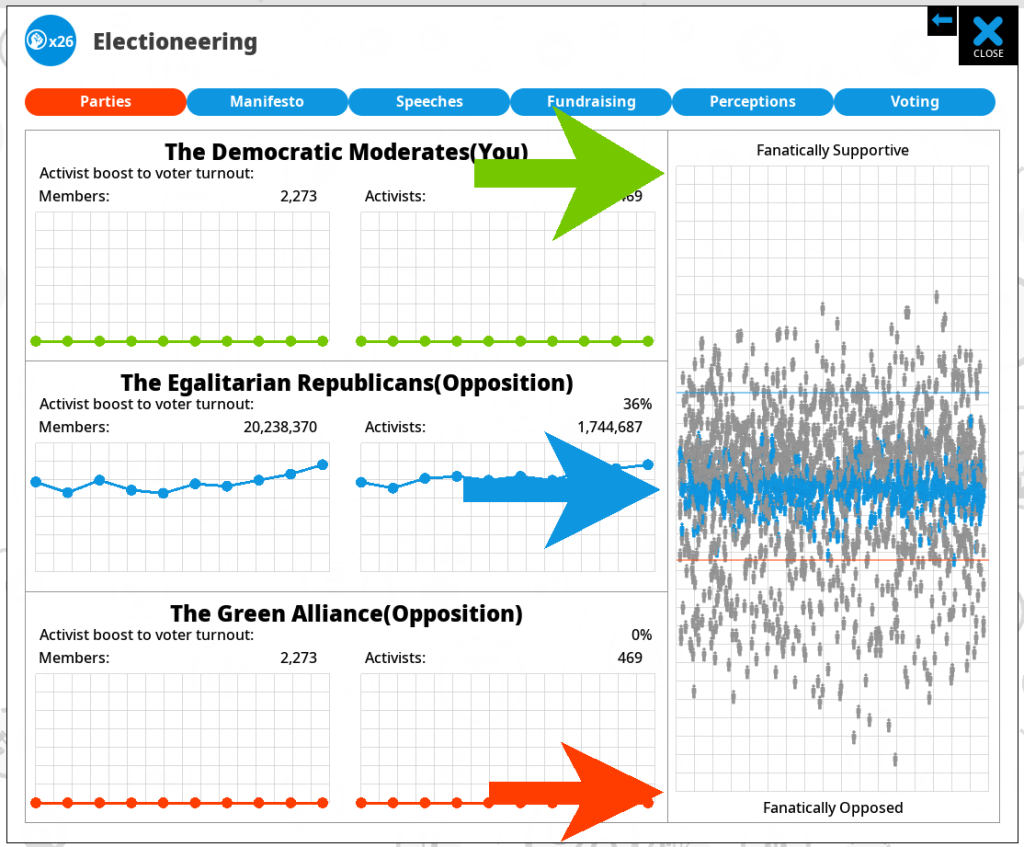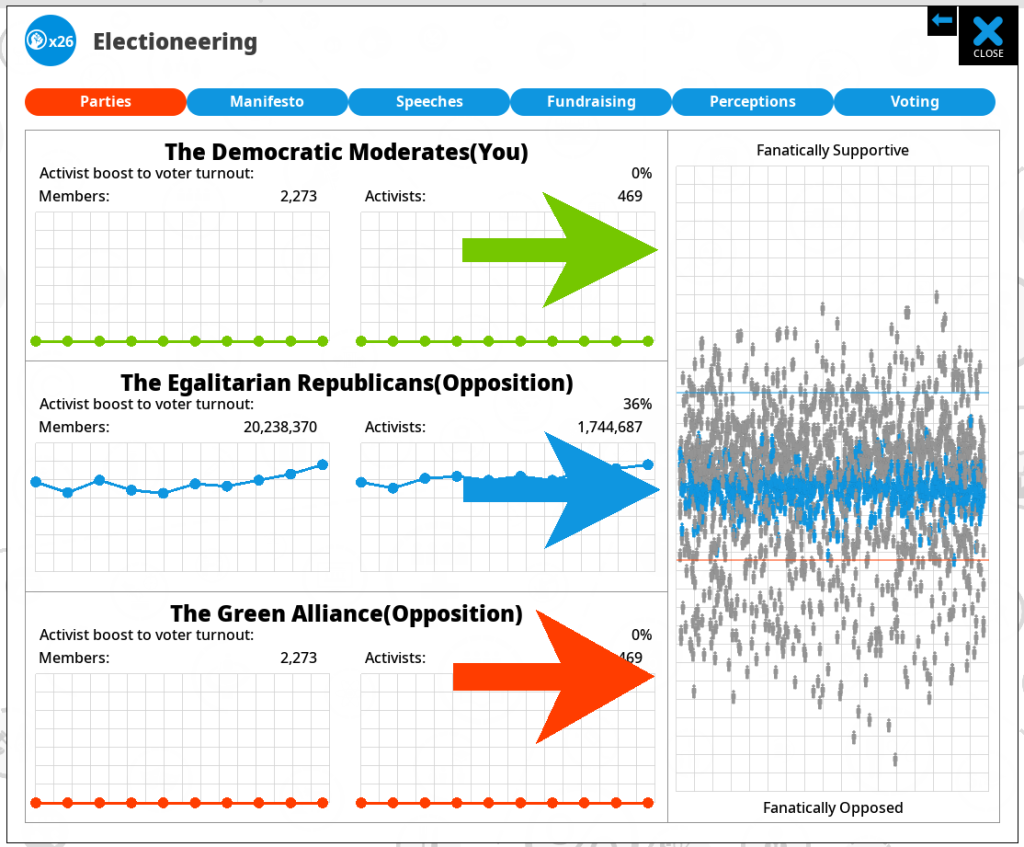I am currently working on some voting systems DLC for Democracy 4. In doing so, I have carried out a lot of testing, and balancing, and evaluating, and have just encountered something that I think is lacking in the game. Or more precisely…wrong…or at least imperfectly modelled.
Take as exhibit A this chart (on the rhs) from the game showing the distribution of happiness (0 at bottom, 100% at top) of all of the simulated voters. Because this is in debug mode it draws 2 exciting lines, which are showing the voting thresholds in the game, drawn across the chart in red and blue

These (hidden from the player) thresholds are used to decide what party voters vote for, have sympathy for, and may even become members or activists for. In a very simple 2 party system, there is just 1 line at 50% (to start with..) in a 3 party system, they are at 40 and 60%. Below 40% = opposition party, 40-60% means centrist party, above 60% means the player party.
Canny maths experts have already spotted that this is not an even split. TRUE! but thats ok, because it represents the fickleness of a first-past-the-post electoral system. If you change it to PR, the game swaps to a 33/66% split, with each party representing one third of the available ‘approval space’ in the game. This is how we represent the fact that voters are more likely to find a party they can support at the ballot box if a more proportional system is used, with fewer wasted votes…
…also I need to point out that the system is not that simple! Over time, the position of the opposition parties moves towards that of the center-of-gravity of the electorate. So if, for example, all the voters are very unhappy, those thresholds will move down, as the opposition parties position themselves so they can win more votes. If you can imagine a new ‘gravitational center’ line in the middle of all the voters, both that red and blue line are getting sprung (to an extent) towards it.
So far so good. Thats how the game works right now.
BUT. Two things are amiss here, and I am now working on improvements. For one thing… in the real world, parties change their positions in order to WIN VOTES not to improve the ‘average approval’ of themselves. In previous blog posts I have labored the point that average approval and voting intention are different things entirely! I have edited the games code for 3 party PR-systems to take this into account. Now… in a 3 party PR system, the opposition parties move towards the gravitational center of voting intention (not approval) only for opposition voters. Let me explain with examples:

The UK has 3 parties of size: Conservative, Labour and Lib Dems. In the old system, the labour and lib dem voters would be essentially moving to a policy position that kept everyone in the UK as happy with them as possible, while still remaining vaguely rooted in their principles. However, in this new system, the Labour/Lib Dem parties will still gravitate towards this position…but the dividing line between those parties will now only be affected by the firm voting intentions of non conservative voters.
Under the old system, a policy change by the non-centrist opposition party (labour), that seriously upset conservatives, but made lib-dem voters happy… would maybe not be adopted, because the average approval of ALL voters (including conservatives) was being measured. Under the new system, labour policy totally ignores the hardcore conservative voters, and is only concerned with winning votes from the lib dems, and more importantly…winning VOTES…not just a change in opinion. So for example, a policy position that has no impact on right-wing lib-dems, but may well win over voters floating between lib-dem and labour…will get adopted.
(Of course the game abstracts this, and you don’t get to see oppositions literal policy positions, but its all represented in the way these thresholds move.)
Why does this matter? Because by making this change, a more sensible position is chosen for that red line. What that means is, under the new algorithm, with a PR system those red and blue parties are more likely to be equal sized, and we are more likely to get coalition outcomes. This is EXACTLY what you would expect under a system of proportional representation.
So thats one change… and something I am definitely still testing, and will be specific to PR, and thus the new DLC. However, when working on this I realised a fundamental misconception about party membership that is unbalancing the game.. <drumroll>
If you look at that chart again (in fact I’ll repeat it with some arrows..) you will see that the 3 parties also have a center point, which is used to determine how much someone believes in the party:

These locations determine how big the membership of your party gets. Someone close to the blue arrow is likely to join the bluie party, someone close to the green arrow is likely to…etc. See the problem?
Yup, the system is total bullshit. The centrist party has its membership center slap bang in the middle of its political sphere, but I placed the other 2 parties at the extremes. At the time, this made sense to me, but now… Ha. no. This makes no sense. Think about political parties on the edge of a mainstream political spectrum. Where are the members and activists? They are likely to be in the same position as the members in the centrist party: At the location CLOSEST to the center of policy position for that party. The voters shown at the red and green arrows are not diehard loyalists! they are the extreme libertarians or fascists or communists who consider the party they vote for to be a reluctant watered down compromise! They are actually the voters on the verge of ‘wasting’ their vote on a fringe party. No! The correct positions should be:

In other words, we should have some red party members here, and ok… maybe not a green party one yet, but certainly more likely than under the old system.
This is a fundamental coding screw up and design miscalculation. Its not exactly critical, but I strive for accuracy of my political modelling. This change will affect non-DLC vanilla games too. If you have been playing Democracy 4 and bemoaning the fact that only the middle party in 3 party countries ever gets any members, you are not wrong to do so. I’ll fix this for the next update.